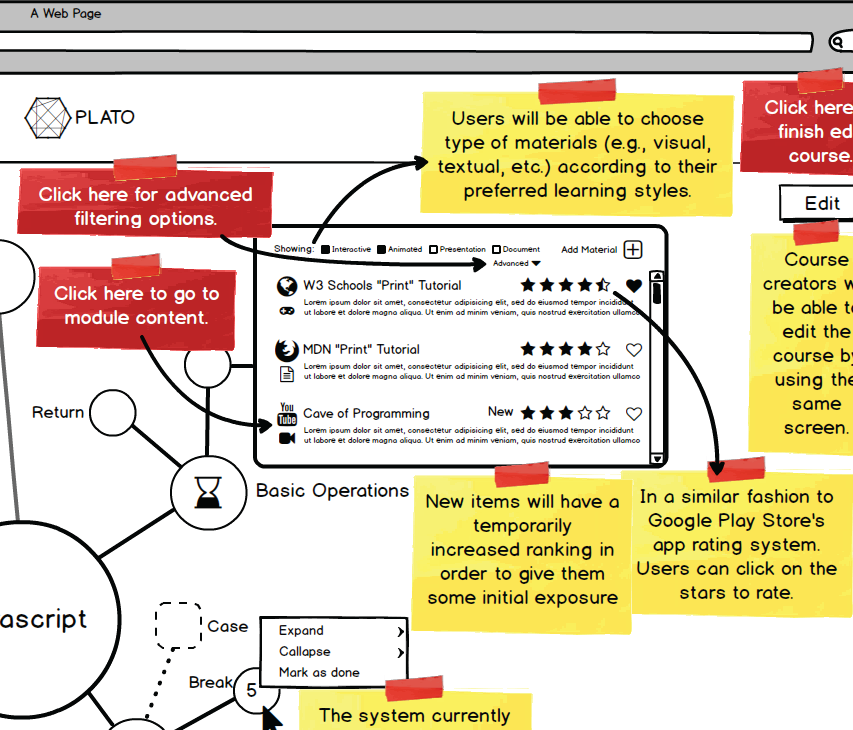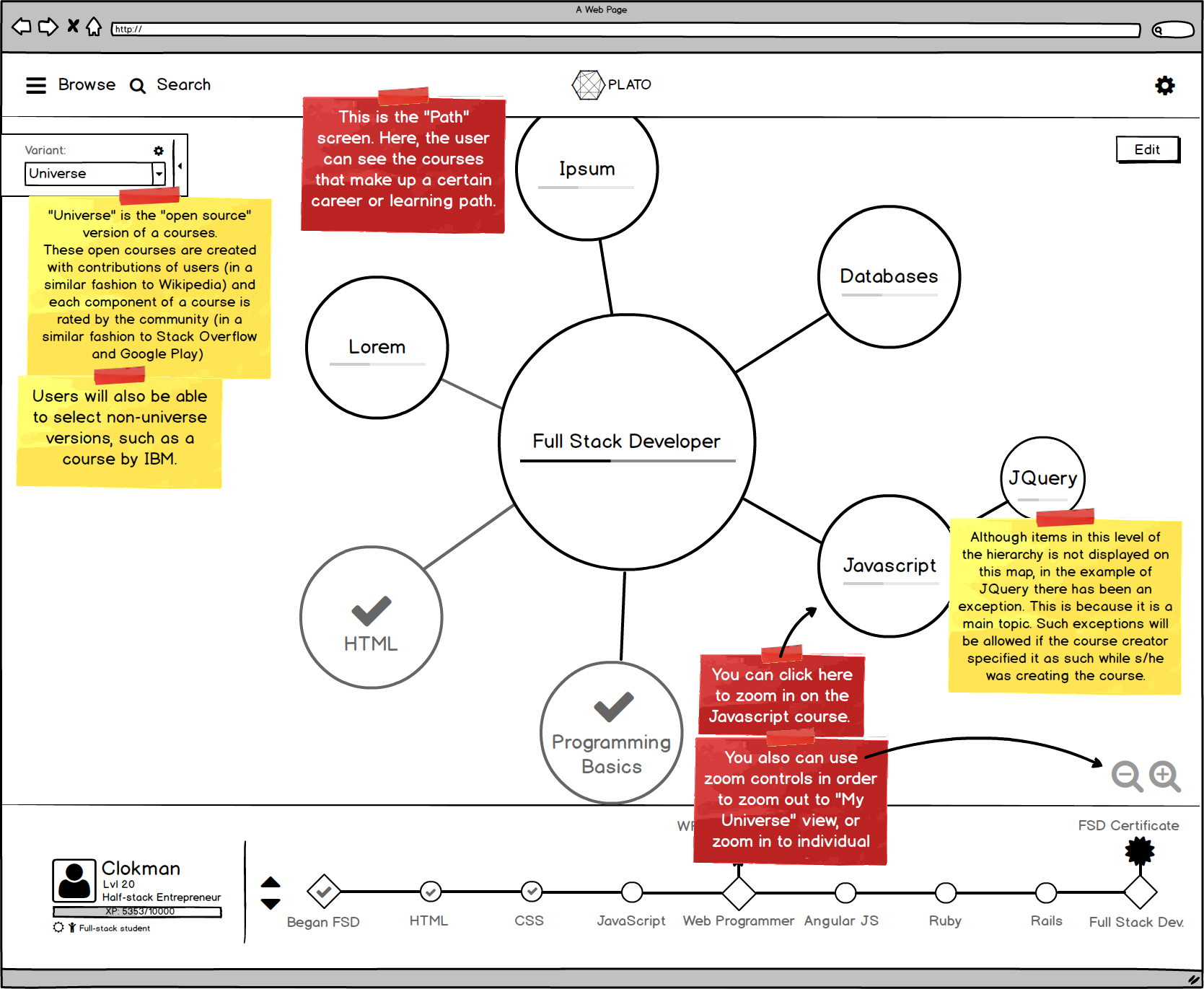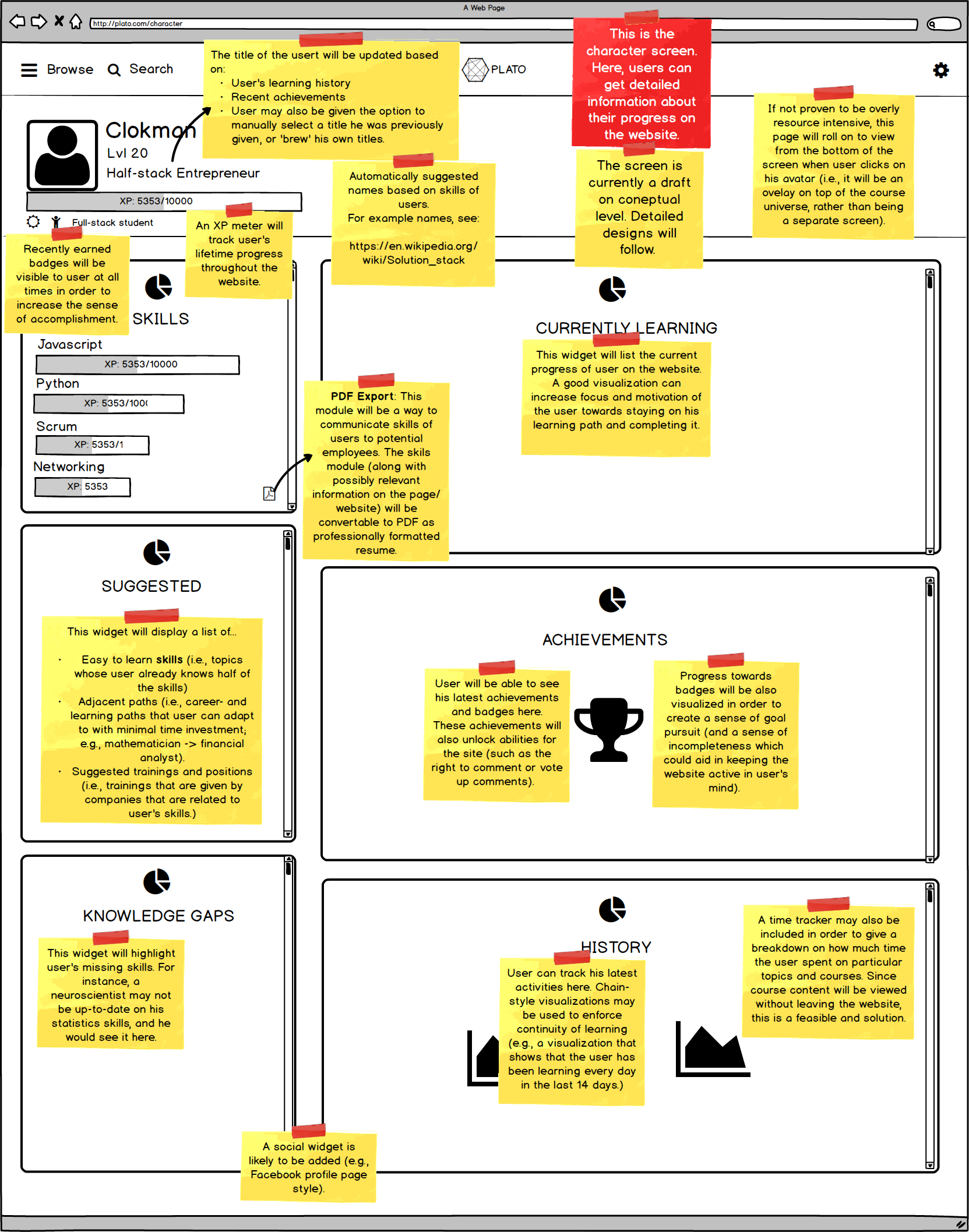Concept and Prototype
This section details the concept and an early prototype of the online education system, Plato.
Overview and purpose
Plato is an online education platform that aims to deliver high-quality and multi-modal educational material in a gamified environment.
What sets it aside from other educational platforms and institutions is, firstly, its community-powered course curation system. This system makes it possible to change even the smallest units of a course (e.g., a tutorial on "print" command) based on user suggestions and ratings11. Image below: Course material view and contribution interface of the system. The "add material" button on upper left side of the dialog allows user contribution.
 , and therefore, facilitates constantly evolving courses. Such flexibility is not available to any other educational method22. For instance on an online education platform such as coursera.com, updating a small component of a course would require, in the best case scenario, video editing, and in the worst case, reproduction of a certain module. And although it could be theoretically easy to update PowerPoint slides in an academic course, it is unlikely that materials would be updated more than once a year (if not in every decade)., and if implemented successfully, this open-source mentality could make it possible to create courses that improve and evolve at an unprecedented speed.
, and therefore, facilitates constantly evolving courses. Such flexibility is not available to any other educational method22. For instance on an online education platform such as coursera.com, updating a small component of a course would require, in the best case scenario, video editing, and in the worst case, reproduction of a certain module. And although it could be theoretically easy to update PowerPoint slides in an academic course, it is unlikely that materials would be updated more than once a year (if not in every decade)., and if implemented successfully, this open-source mentality could make it possible to create courses that improve and evolve at an unprecedented speed.
Naturally, maintaining quality of materials and providing a coherent course structure in such a flexible environment would be one of the major challenges of such a platform. However, as Wikipedia and StackOverflow models has shown, when provided the right environment and tools, communities can be surprisingly good at self-organizing and self-correcting. Therefore, the success of Plato's flexible paradigm is likely depend on the correct implementation.
Another unique feature of the platform is its ability to give users access to multiple ways to learn a topic. By showing alternative educational materials available for each topic (e.g., textual, visual/instructional, or interactive/hands-on ways to learn a function in Javascript language), it would give users the option to learn in a way that fits their learning preferences and unique needs.
This would eventually lead to a democratic selection of educational materials, which is unlikely to be the case in today's higher education—a system in which students have to settle for what the system and their instructor has designed and chosen for them (usually text-based PowerPoint slides and pages of text to read). Indeed, even though it is estimated that at least %30-60 of students prefer to learn visually (Felder & Soloman, 2006; Buşan, 2014), and only 10 percent prefer to learn only through verbal and auditory means, 80 percent of instructional delivery is thought to be through textual or auditory media (University of Illinois Extension, 2016). Furthermore, availability of educational materials in different modalities would also be an enabling factor for neurologically diverse populations such those with dyslexia33. Although it might be perceived as an neurological minority, every 1 out of 10 people are thought to have dyslexia, which amounts to 700 million people in the world (Dyslexia International, 2014). who are in need of multi-modal (e.g., visual, auditory, and kinesthetic) instruction (Dyslexia International, 2014; Sheffield, 1991), or such as those with autism who excel in visual thinking (Grandin, 1996).
Style and gamification elements
Plato is a persistent world and visual space which would house a representation of knowledge and skills of its users, and allow them to grow further through recommending and providing materials.
In Plato's interface, each career path, skill and topic is represented as a hierarchical network with a central node in the middle (which changes based on what the user currently focuses on), much like a mind map. This representation style yields benefits that a linear list cannot provide. Besides being a more accessible representation of dependencies and structure of a course than a list, a map would allow users to choose their own path while still providing a degree of linear structure where necessary (e.g., by making it obligatory to complete a dependency before being able to move on to another topic). This sense of agency in choosing one's path can be expected to increase one's motivation and commitment to continue a learning path, compared to someone who feels obliged to follow an externally imposed structure 44. Although it can be argued that one may skip elements in a linear course in case they are already known, it is highly probably that individuals would have concerns about not being able to understand a topic further down the road because of a skipped topic, and thus, complete the modules even if there is not much learning value in them. This can be expected to create low engagement and motivation..
Furthermore, having a clear representation contents of one's mind (i.e., knowledge, skills, and learning goals) in a persistent world, is highly likely to create more engagement by providing a sense of identification with user's assets on the platform, and make the time a user may spend on the system feel like investing in one's self. This connection between the user's virtual and the actual psyches will be strengthened further by usage of an avatar that evolves (e.g., with new titles) as user progresses through the system, and a sense of investment will be symbolically strengthened by introducing periodical introduction of rewards in the form of achievements and privileges (e.g., more voting power compared to more novice users upon completion of a module).
An important implication of the persistent world paradigm is the transferrability of skills through courses. For instance, if a user has already learned about basic programming skills in a previous course, this module would be marked as accomplished in a following course. Although maintaining an accurate picture of what a user knows (and what to omit) based on this information would present an implementation challenge, the high granularity of instruction and progress measurement (i.e., the ability to track minute details such as if a user learned the 'print' function in a course) is expected to make this a feasible feature to implement. Upon successful implementation, such transferrability of skills would allow accelerated learning, and would likely result in a boost of motivation in cases where user notices that learning a new skill will be quite easy due to the fact that s/he already possesses thirty percent of knowledge. In a similar way, users may be suggested skills to learn or even career paths to consider based on what they already know and how much effort it would be required from them to grow in a certain direction. (Initial designs of this and other gamification elements can be seen in the wireframe of the character screeen provided below.
Other gamification elements in the system include...
• Experience points gained per educational module completed (whose amount could be automatically adjusted by what the user already knows in combination with the community-reported difficulty rating of a topic)
• A perpetually present progress bar, and quest log (i.e., for activating goals) combined with a linear visualization of milestones located at the bottom of the interface (such a quest and milestone system is intended for providing structure and for goal setting) and sharing quests with individuals. 55. Image below: A character and experience bar at the bottom of the screen would help users to track their overall progress in the system, as well as in a particular learning path. 
• Social questing or co-op mode by sharing learning goals with one's friends online.
• A detailed history module that provides user with feedback on his performance
• Use of a chains paradigm in order motivate users to continue their paths (e.g., by prompting them that they have been training one hour each week on the system for the last two months, and representing this with a chain.)
• A 'my universe' screen which provides an overview of all the activities the user has completed and is currently continuing
• Real-world rewards based on internship and job opportunities with companies
Further explanation on game dynamics and style of the system is provided through notes in the wireframes in the Ximpel sandbox constructed for the purposes of this project. This sandbox can be found in the prototype section.
Feasibility and existing systems
Although the suggested platform is an original one with no previous examples, it borrows paradigms and technologies from many existing systems.
Examples of such paradigms and tecnhologies can be summarized as following:
- Visual style from games such as Eufloria and Osmos, task management software such as Droptask, and mindmapping technique from education & structured thinking area
- The persistent world, experience, and evolving character paradigms from multiplayer online games such as World of Warcraft
- Online education paradigms from systems such as Codecademy.com, Lynda.com, Udemy.com, and Coursera.org.
The existence and success of these precedents indicate feasibility of the system, and combining paradigms from these successful precedents is likely to provide a good foundation for the platform.
The platform is currently being realized with a team of software developers and it utilizes technologies such as HTML, Javascript (Angular.js) and D3. In the beginning phase, the platform will be funded by existing funds and sponsors and eventually incorporate subscription-based services for its users.
Implications
The system has the potential to provide education to a diverse range of audiences with unparalleled quality and customizability. This would eventually lead to a more democratic education not only for economically but also neurologically disadvantaged populations due to the current design of the education system.
Futhermore, by hosting ever-improving and multi-modal educational materials on a diverge range of topics, the system has the potential to aid instruction in higher education and help scientific knowledge to be disseminated more efficiently and effectively than today.
Besides its educational capabilities, by providing a range of gamification and tracking functions, it has the potential to evolve into a lifelong learning companion for individuals and become the YouTube or Wikipedia of education.
Prototype
A low-fidelity prototype of the system was developed using Balsamiq and Ximpel and it can be launched below. This prototype is intended as a walkthrough and includes extensive notes detailing the functionality and feel of the system, and therefore, is a continuation of this section.
References
Dyslexia International. (2014). Dyslexia International report. Retrieved from http://www.dyslexia-international.org/wp-content/uploads/2016/04/DI-Duke-Report-final-4-29-14.pdf
Felder, R. M., & Soloman, B. a. (2006). Learning styles and strategies. Retrieved July 3, 2016, from http://www4.ncsu.edu/unity/lockers/users/f/felder/public/ILSdir/styles.htm
Grandin, T. (1996). Thinking in pictures : and other reports from my life with autism. Vintage Books. Retrieved from http://www.grandin.com/inc/visual.thinking.html
Sheffield, B. B. (1991). The structured flexibility of Orton-Gillingham. Annals of Dyslexia, 41(1), 41–54. http://doi.org/10.1007/BF02648077
University of Illinois Extension. (2016). Learning Styles.

